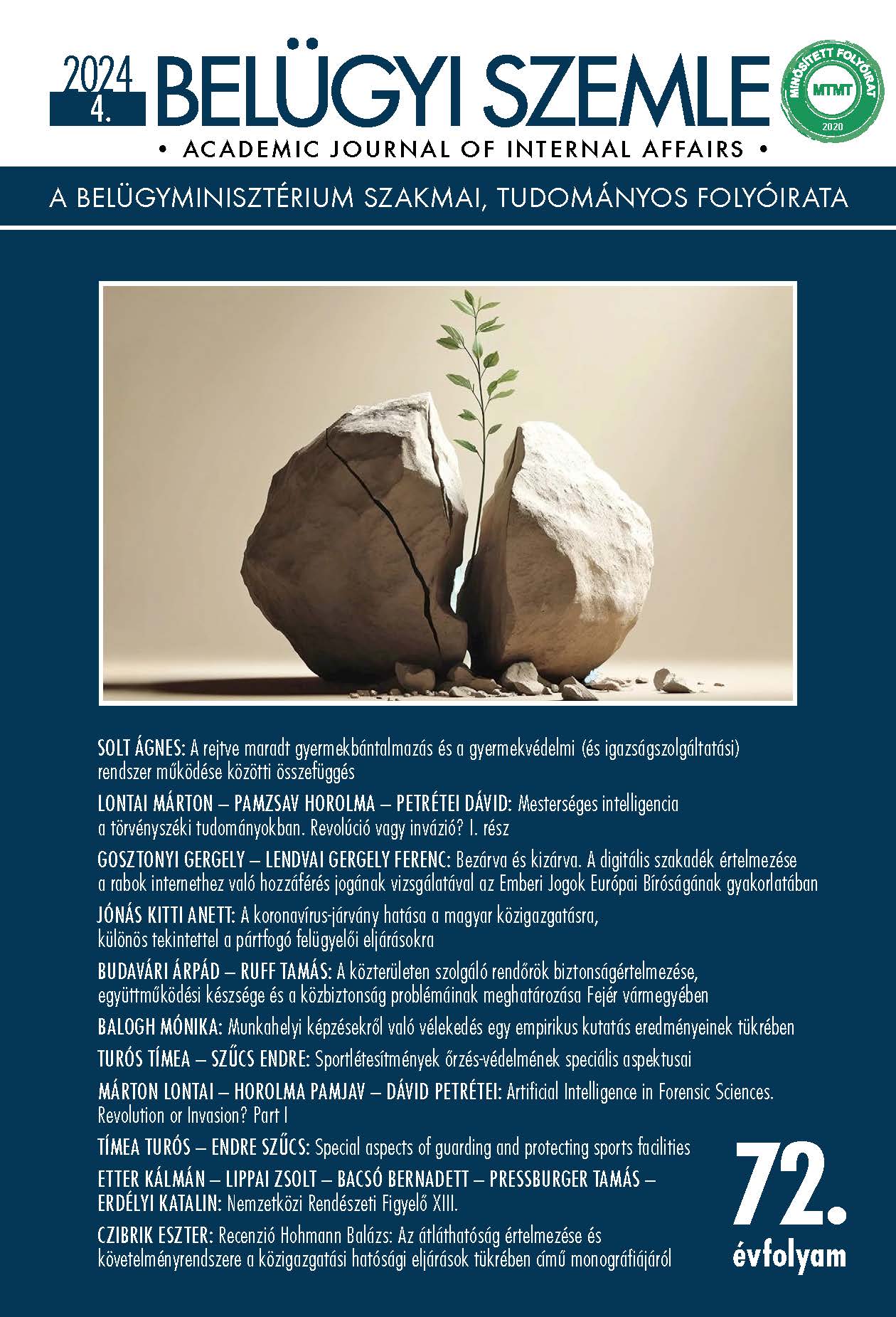Absztrakt
Cél: A kétrészes tanulmány első fele bemutatja a mesterséges intelligencia növekvő szerepét a forenzikus tudományok művelésében. Az alapfogalmak tisztázását és a rövid történeti áttekintést követően sorra veszi a mesterséges intelligencia (MI) alkalmazásának lehetőségeit a különféle forenzikus szakterületeken: genetika, nyomtan, vegyészet, toxikológia, antropológia, igazságügyi orvostan.
Módszertan: A tanulmány számos, közelmúltban megjelent külföldi szakcikk feldolgozásával azok szintézisét végzi el.
Megállapítások: A mesterséges intelligencia alkalmazásának behatolása az egyes tudományterületekre napjainkban is zajló folyamat. Ezt a fejlődést nem kerülhetik el a legváltozatosabb forenzikus szakterületek sem. A hagyományos módszerekkel kezelhetetlen méretű adatbázisokban való eligazodás, a mintafelismerés, a gépi tanulás mind hasznos eszköz lehet a forenzikus tudomány műveléséhez is. Fontos következtetés azonban, hogy az MI a szakértői munka támogatója, nem helyettesítője.
Érték: Magyar nyelven a forenzikus tudományok területén ilyen részletes összefoglaló szakcikk eddig nem született.
Hivatkozások
Angyal M. & Petrétei D. (2019). A magyarországi áldozatazonosítási szolgálat felállításának kihívásai és tapasztalatai. Nemzeti Közszolgálati Egyetem.
Bedeli, M., Geradts, Z. & van Eijk, E. (2018). Clothing identification via deep learning: forensic applications. Forensic Sciences Research, 3(3), 219–229. https://doi.org/10.1080/20961790.2018.1526251
Bewles, J., Low, A., Morphett, A., Pate, F. D. & Henneberg, M. (2019). Artificial intelligence for sex determination of skeletal remains: application of a deep learning artificial neural network to human skulls. Journal of Forensic and Legal Medicine, 62(1), 40–43. https://doi.org/10.1016/j.jflm.2019.01.004
Cantürk, İ. & Özyılmaz, L. (2018). A computational approach to estimate postmortem interval using opacity development of eye for human subjects. Computers in Biology and Medicine, 98(4), 93–99. https://doi.org/10.1016/j.compbiomed.2018.04.023
Chinnikatti, S. K. (2018). Artificial Intelligence in Forensic Science. Forensic Science & Addiction Research, 3(1). http://dx.doi.org/10.31031/FSAR.2018.03.000554
Dotzert, M. (2021). The Power of Algorithms in Analytical Chemistry. https://www.labmanager.com/insights/the-power-of-algorithms-in-analytical chemistry-23167
Galante, N., Cotroneo, R., Furci, D., Lodetti, G. & Casali, M. B. (2022). Applications of artificial intelligence in forensic sciences: Current potential benefits, limitations and perspectives. International journal of legal medicine, 137(2), 445–458. https://doi.org/10.1007/s00414-022-02928-5
Gasteiger, J. (2020). Chemistry in times of artificial intelligence. Chemphyschem: a European journal of chemical physics and physical chemistry, 21(20), 2233–2242. https://doi.org/10.1002/cphc.202000518
Hassan, M., Wanga, Y., Wang, D., Li, D., Liang, Y., Zhou, Y. & Xu, D. (2021). Deep learning analysis and age prediction from shoeprints. Forensic Science International, 327, 110987. http://dx.doi.org/10.1016/j.forsciint.2021.110987
Kamdar, S. R. & Pandey, A. (2011). The Scope of Artificial Intelligence in Forensic Science. The Indian Police Journal, 58(3), 48–51.
Mahasantipiya, P. M., Yeesarapat, U., Suriyadet, T., Sricharoen, J., Dumrongwanich, A. & Thaiupathump, T. (2011). Bite mark identification using neural networks: a preliminary study. Proceedings of the International MultiConference of Engineers and Computer Scientists, 1, 16–18.
Marciano, M. A. & Adelman, J. D. (2019). Developmental validation of PACE™: Automated artifact identification and contributor estimation for use with GlobalFiler™ and PowerPlex® fusion 6c generated data. Forensic Science International: Genetics, 43, 102140. https://doi.org/10.1016/j.fsigen.2019.102140
Mesejo, P., Martos, R., Ibáñez, Ó., Novo, J. & Ortega, M. (2020). A survey on artificial intelligence techniques for biomedical image analysis in skeleton-based forensic human identification. Applied Sciences 10(14), 4703. https://doi.org/10.3390/app10144703
Moretti, T. R., Just, R. S., Kehl, S. C., Willis, L. E., Buckleton, J. S., Bright, J. A., Taylor, D. A. & Onorato, A. J. (2017). Internal validation of STRmix™ for the interpretation of single source and mixed DNA profiles. Forensic Science International: Genetics, 29,
Spivak, B. L. & Shepherd, S. M. (2021). Ethics, artificial intelligence, and risk assessment. The journal of the American Academy of Psychiatry and the Law, 49(3), 335–337. https://doi.org/10.29158/JAAPL.210066-21
Szabó, B. T. (2019). A CBCT képalkotó megbízhatóságának vizsgálatai. Doktori értekezés. Semmelweis Egyetem Klinikai Orvostudományok Doktori Iskola.
Taylor, D., Harrison, A. & Powers, D. (2016). An artificial neural network system to identify alleles in reference electropherograms. Forensic Science International: Genetics, 30, 114–126. https://doi.org/10.1016/j.fsigen.2017.07.002
Taylor, D., Harrison, A. & Powers, D. (2019). The generalisability of artificial neural networks used to classify electrophoretic data produced under different conditions. Forensic Science International: Genetics, 38, 181–184. https://doi.org/10.1016/j.fsigen.2018.10.019
Thurzo, A., Kosnáčová, H. S., Kurilová, V., Kosmel, S., Beňuš, R., Moravanský, N., Kováč, P., Kuracinová, K. M., Palkovič, M. & Varga, I. (2021). Use of Advanced Artificial Intelligence in Forensic Medicine, Forensic Anthropology and Clinical Anatomy. Healthcare, 9(11), 1545. https://doi.org/10.3390/healthcare9111545
Zhou, Z. & Zare, R. N. (2017). Personal information from latent fingerprints using desorption electrospray ionization mass spectrometry and machine learning. Analitical Chemistry, 89(2), 1369–1372.

This work is licensed under a Creative Commons Attribution-NonCommercial-NoDerivatives 4.0 International License.
Copyright (c) 2024 Belügyi Szemle

